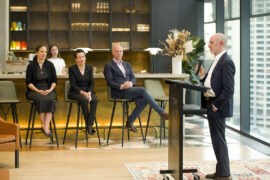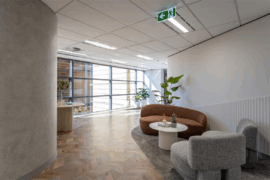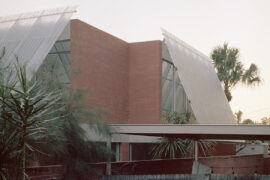From hybrid that works, to hybrid that doesn’t, AI futures, buzz words explained, the roadmap to ROI plus more: Here are five workplace learnings from Worktech Melbourne 2023.

Quay Quarter Tower, photograph by Adam Mork.
March 29th, 2023
The hybrid office: does it work? Doesn’t it? How should it work? The conversation at Worktech’s Melbourne conference, really centred around this. Krupa Solanki, innovation director at UnWork, chaired the event, highlighting valuable takeaways and her own observations as she skilfully drew together the diverse cross-section of speakers who represented disciplines of architecture, design, strategy, experience, technology and AI, and so much more. As presenters they were each charismatic, contributing great value to the audience through their intersecting knowledge and experience.
Many of the models, approaches and strategies, as well as cases in point presented, were of the cutting-edge variety. It gave the audience an insight into what is possible and offered a stark counterpoint to what one speaker referred to as “original reality” (real life, as opposed to virtual reality).
Book your place at Worktech Sydney, taking place next Tuesday 4 April; read the conference agenda.

With so much to absorb across the 9+ hours of knowledge shared, here are five things that really stuck with me.
As ERA Co’s Nick Todd pithily pointed out (as he blew up and broke down common workplace buzz words): What does hybrid mean, anyway? There is no one-size-fits-all solution to a workplace adopting hybrid working. No one is winning in this space and there are a million different variables.
All the survey results that I have absorbed in the past month point towards roughly half of all workers choosing to work hybrid. Choice is the common theme here. And as Matthew Myerson of the Worktech Academy noted, there’s a real fight or flight energy around returning to work. Leaders are angling for staff to return while the workforce continues to express its desire for continued flexibility. One thing we do know is to dictate a return to work will leave leaders the losers.

AI is here and everyone who is brave enough to jump in feet first is having a dabble with it. The possibilities for what AI can do for business’ productivity and prosperity are indeed exciting. But a few things to take note of: know the AI’s limitations – because it does have limitations – and take advantage of its capabilities. AI is still gearing up in the area of ethics. In the long term, says Eduard Hovy, executive director of Melbourne Connect at the University of Melbourne, we will most likely see people with their own personal ‘chatbots’ which are individualised to tasks and users.

Aaron Taylor-Harvey, creative director of Spaces Of, spoke about how the digital fluency and remote productivity of employees is leading to the extinction of the traditional office environment. He noted that most employees do want to come into the office, just not every day. More likely two to three days a week. Taylor-Harvey broke down the equation to present an office space in which only 22 per cent of space need be devoted to desking, while 78 per cent of the space can be used for something else. For those very willing to come to the office for specific desk time, we must make that desk time incredibly valuable. Make sure your 22 per cent of desking is really stand-out.

We talk about this a lot in our upcoming issue of Indesign magazine #89, The ‘Magnetic Workplace’ Issue, contact us to pre-order your issue.
Culture and purpose, which have long been treated as intangible qualities that we experience and cultivate through our togetherness at work, have come to the fore as qualities that must be articulated and built out through storytelling and empathetic leadership styles. Melissa Marsden, director of COMUNiTI, and author of The Next Workplace, presented a roadmap for employee experience that involves the connection of heart (the collective emotion of a space; the culture), with mind (technology made easy, accessible and frictionless), and body (the physical environment put together for flexibility, agility, performance). When you get this right, it can lead to increased job satisifaction and performance, reduction in staff turnover, and an ROI in business.

This community-oriented vertical village in Sydney’s CBD has been touted as humanising the high rise. It’s also impressive for its carbon saving qualities. 3XN partner, Gry Kjær, presented a case study of the building and shared many statistics that reveal just how architecture has been able to redevelop this legacy high rise in an environmentally positive manner. 3XN with its projects partners retained 65 per cent of the original building structure (beams, columns, and slabs), and 95 per cent of the original core. This has resulted in an embodied carbon saving of 12,000 tonnes. That’s the equivalent of 35,000 flights between Sydney and Melbourne. And you can’t really argue with that. Read Indesignlive’s QQT project review.

Attend Worktech Sydney conference next Tuesday, 4 April, 8.30am-5.15pm at the Art Gallery of NSW, Sydney. Read the program here.
Worktech
worktechevents.com
Photography
Courtesy of Worktech
INDESIGN is on instagram
Follow @indesignlive
A searchable and comprehensive guide for specifying leading products and their suppliers
Keep up to date with the latest and greatest from our industry BFF's!

Merging two hotel identities in one landmark development, Hotel Indigo and Holiday Inn Little Collins capture the spirit of Melbourne through Buchan’s narrative-driven design – elevated by GROHE’s signature craftsmanship.

London-based design duo Raw Edges have joined forces with Established & Sons and Tongue & Groove to introduce Wall to Wall – a hand-stained, “living collection” that transforms parquet flooring into a canvas of colour, pattern, and possibility.

A calm, gallery-like boutique by Brahman Perera for One Point Seven Four brings contemporary luxury and craft to Strand Arcade.

BLP’s new Sydney Children’s Hospital, Randwick building brings together paediatric care, family-centred design and Australia’s first Children’s Comprehensive Cancer Centre in a major addition to the Randwick Health & Innovation Precinct.

The eponymous practice founder reflects on four decades of work in a new book launched by Lord Mayor Clover Moore, tracing lessons from New York to Sydney and revisiting seminal works including 8 Chifley Square and the Andrew “Boy” Charlton Pool.

A thoughtful, low-waste redesign by PMG Group in collaboration with Goodman has transformed a dated office into a calm, contemporary workspace featuring a coastal-inspired palette and Milliken flooring for a refined finish.
The internet never sleeps! Here's the stuff you might have missed

From the spark of an idea on the page to the launch of new pieces in a showroom is a journey every aspiring industrial and furnishing designer imagines making.

With 26 shortlisted homes, a 13-member jury and four standout winners, the 2025 Habitus House of the Year program wrapped up last night in Sydney with Winnings.